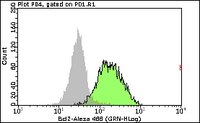FCMAB250A4 Sigma-AldrichMilli-Mark Anti-Bcl-2 Antibody, Alexa Fluor®488, clone AW604
This Milli-Mark Bcl-2 antibody is validated for use in Flow for the detection of the Milli-Mark Bcl-2 protein.
More>> This Milli-Mark Bcl-2 antibody is validated for use in Flow for the detection of the Milli-Mark Bcl-2 protein. Less<<Recommended Products
Overview
| Replacement Information |
|---|
Key Spec Table
| Species Reactivity | Key Applications | Host | Format | Antibody Type |
|---|---|---|---|---|
| H | FC | M | AlexaFluor®488 | Monoclonal Antibody |
| References |
|---|
| Product Information | |
|---|---|
| Format | AlexaFluor®488 |
| Control |
|
| Presentation | Purified mouse monoclonal IgG2a conjugated to Alexa Fluor® 488 in PBS with 0.1% sodium azide and 15 mg/mL BSA. |
| Quality Level | MQ100 |
| Applications | |
|---|---|
| Application | This Milli-Mark Bcl-2 antibody is validated for use in Flow for the detection of the Milli-Mark Bcl-2 protein. |
| Key Applications |
|
| Physicochemical Information |
|---|
| Dimensions |
|---|
| Materials Information |
|---|
| Toxicological Information |
|---|
| Safety Information according to GHS |
|---|
| Safety Information |
|---|
| Product Usage Statements | |
|---|---|
| Quality Assurance | Evaulated by flow cytometery using Jurkat cells. |
| Usage Statement |
|
| Storage and Shipping Information | |
|---|---|
| Storage Conditions | Maintain refrigerated at 2-8 °C protected from light in undiluted aliquots for up to 6 months from date of receipt. |
| Packaging Information | |
|---|---|
| Material Size | 100 tests |
| Transport Information |
|---|
| Supplemental Information |
|---|
| Specifications |
|---|
| Global Trade Item Number | |
|---|---|
| Catalogue Number | GTIN |
| FCMAB250A4 | 04053252290091 |
Documentation
Milli-Mark Anti-Bcl-2 Antibody, Alexa Fluor®488, clone AW604 SDS
| Title |
|---|
Milli-Mark Anti-Bcl-2 Antibody, Alexa Fluor®488, clone AW604 Certificates of Analysis
| Title | Lot Number |
|---|---|
| Milli-Mark Bcl-2-Alexa Fluor#174;488, clone AW604 - NRG1807933 | NRG1807933 |
| Milli-Mark Bcl-2-Alexa Fluor®488, -2801956 | 2801956 |







